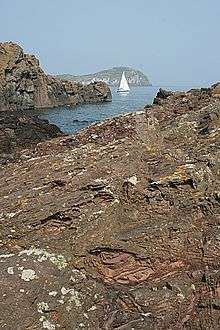Mugearite
Mugearite (/ˈmʌɡiəraɪt/) is a type of oligoclase-bearing basalt, comprising olivine, apatite, and opaque oxides. The main feldspar in mugearite is oligoclase.[1]
| Igneous rock | |
 Mugearite lava flow (on right); flow on left is hawaiite; at North Berwick, Scotland | |
| Composition | |
|---|---|
| oligoclase, olivine |
The rock type was first identified at Mugeary on the island of Skye, Scotland by Alfred Harker in 1904.[2] This mugearite was formed during a period of volcanic activity that happened in western Scotland during the Paleogene period of the Earth's geological history. Outcrops of mugearite of this age also occur on the island of Mull.
Analysis of a Martian rock found by the Curiosity rover and named "Jake Matijevic" (or "Jake M"), after a NASA engineer, determined that the martian rock was very similar to terrestrial mugearite.[2][3][4][5]
References
- Mugearite
- Amos, Jonathan (17 October 2012). "Cosmic coincidence on the road to Glenelg". BBC News. Retrieved 20 October 2012.
- Stolper, E.M.; Baker, M.B.; Newcombe, M.E.; Schmidt, M.E.; Treiman, A.H.; Cousin, A.; Dyar, M.D.; Fisk, M.R.; Gellert, R.; King, P.L.; Leshin, L.; Maurice, S.; McLennan, S.M.; Minitti, M.E.; Perrett, G.; Rowland, S.; Sautter, V.; Wiens, R.C.; MSL ScienceTeam (2013). "The Petrochemistry of Jake_M: A Martian Mugearite". Science. AAAS. 341 (6153): 1239463. Bibcode:2013Sci...341E...4S. doi:10.1126/science.1239463. PMID 24072927.
- Grotzinger, John (September 26, 2013). "Introduction To Special Issue: Analysis of Surface Materials by the Curiosity Mars Rover". Science. 341 (6153): 1475. Bibcode:2013Sci...341.1475G. doi:10.1126/science.1244258. PMID 24072916. Retrieved September 27, 2013.
- Webster, Guy; Brown, Dwayne (September 26, 2013). "Science Gains From Diverse Landing Area of Curiosity". NASA. Retrieved September 27, 2013.
This article is issued from Wikipedia. The text is licensed under Creative Commons - Attribution - Sharealike. Additional terms may apply for the media files.